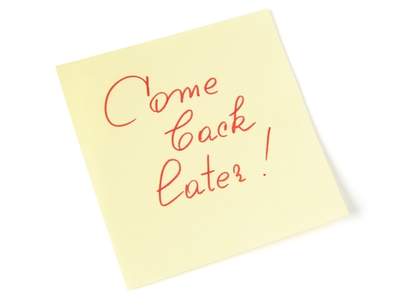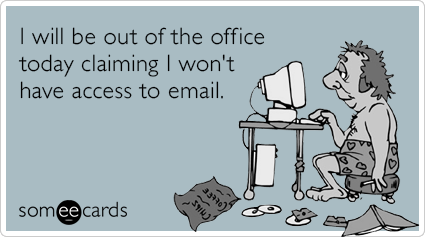Does this sound familiar …
Thank you for your message. I will be away from the office between XX date and XX date. During that time, I will have limited access to email and voicemail. If you need assistance before I return, please contact XX at (xxx) xxx-xxxx or [email protected]. Have a nice day!
Name
Title
Contact Info
Company
Logo
Motivational Quote
 Does anything exemplify the banality of office culture more than the standard out of office message? I was quiet thankful when Outlook introduced the proactive feature of delivering an out of office teaser when an email is first addressed to a missing recipient, as it saved me the having to not read and blindly delete a host of replies, especially around the holidays.
Does anything exemplify the banality of office culture more than the standard out of office message? I was quiet thankful when Outlook introduced the proactive feature of delivering an out of office teaser when an email is first addressed to a missing recipient, as it saved me the having to not read and blindly delete a host of replies, especially around the holidays.
Yes, out of office messages serve a purpose. Most try to serve two:
- Tell the sender that you aren’t available to talk.
- Inform the sender where to go for help in your absence.
That’s nice. However, given my already EPIC hatred of email as a misguided collaboration tool, this particular contrivance really ignites my internal Lewis Black. While email isn’t going anywhere anytime soon, I think we can fix this particular feature ourselves – right now.
Why it matters …
Yes, I’m nitpicking corporate culture. But small changes have the potential power to influence meaningful culture shifts down the line. In the people mazes that global organizations can be, paying attention to details like this can also help you stand out. That can be good or bad, depending on your company and objectives when being “different.”
My issues with the standard out of office message are …
- No one reads them. They are as useful as bounce-back notifications. Receive > Delete.
- They’re boring. They literally all look the same and therefore say nothing about you as an individual.
- They provide no value other than telling me you aren’t available, which is already an inherently negative message to the sender. I needed you, but you can’t help me … and now I have to delete your statement of uselessness from my already crowded inbox.
- They usually aren’t exactly true. What does “limited access to email/voicemail” really mean? Unless you are getting your adventure on while you are away, you are probably carrying a mobile device that grants you considerable access. It’s not about access – you just don’t want to pay attention. That’s fine, but why do we talk around it? Even worse – why do we contradict ourselves and reply while away?!?!
- The “here’s who to contact” piece is indicative of a greater organizational issue, as it shouldn’t require your absence and an email for me to understand where my resources are available.
As long as email stumbles on as the primary means of workplace communication, the out of office auto-reply must also survive. However, we can defy it’s ingrained tediousness by making a few small changes to the all-too-familiar message template.
Here are a few fun examples – some more daring than others.
Making it better …
Here are my simple, practiced suggestions for a better receiver out of office message experience …
- Get to the point. Kill the awkward formality and tell me what’s up. Are you GONE gone or just semi-available? When will you be back? Anything else I need to know, especially about timely work? When possible, try to put the basic details in the subject of your message so people get maximum value without opening (because most won’t).
- Be straightforward. Like I said, we know what “limited access” really means. Just say it – you’re not working and therefore you’re not working. Save the extra text for something more interesting (below). Oh – and if we work in the same organization, don’t include your signature. Given that I emailed you, I can certainly find you.
- Insert your personality. How would YOU tell someone you’ll be away for a while? No, you don’t have to tell me exactly where you’ll be, although that would be a nice addition so we can share in your adventures. Don’t be afraid to add a workplace-appropriate sense of humor in your message. Yes, it should fit your org culture. Last time I checked, most companies don’t have a “Boring Out of Office Message” policy (unless it’s buried under the similarly-silly social media policy).
- Add useful information. What else can you tell me that may be of use during our short, one-way conversation? Any recent articles you’ve found of interest related to your job? Will you be working on something interesting when you get back? Take this opportunity to help me better understand both who you are and what you do.
- Make resource availability an everyday consideration. Publish resources, including people who act as your backup, in a shared location NOW. Then, when it’s time to go out of office, link me to that existing resource so I always know where to go – even if you forget the auto-reply one day.
When you take the time to build an engaging, useful out of office message, people will notice. This will not only differentiate you from your peers, it will often lead to additional, interesting replies and side conversations with people who were previously only interested in how you could help them via emails.
Next level awesome …
You don’t have to stop with an improved auto-reply to solidify your spot as the ruler of the out of office status. Here are a few more suggestions to really set yourself apart …
Cover EVERY system
- In the modern workplace, email probably isn’t your only collaboration tool that includes a status function. Have a social network? Voicemail? Intranet profile? Be sure that your absence is noted consistently for maximum awareness. This is especially useful for lengthy periods away from the office.
The In the Office Out of the Office
- If you spend most of your office time in an actual office, place a message in your physical work space so passersby are also aware of your absence. After all, people may also come looking for help in person and shouldn’t be left wondering if you stepped away for lunch – for a week.
Go Video
- Wanna really put your personality into your message? Record a very brief but engaging video message to accompany your email. If you’re tech allows, embed the video in your response. Otherwise, provide a link to a shared video repository. Of course, just like emails, remember that this can get forwarded to everyone/anyone, including people outside your organization.
How do you feel about the out of office message? Do you do anything “different” when it comes to this standard of workplace communication? Am I just nitpicking? Let me know what you think via comments below!



